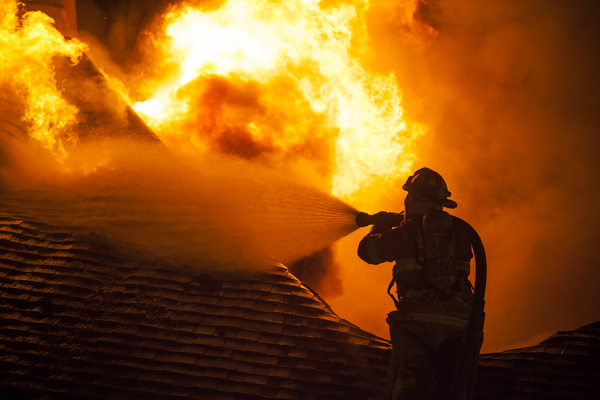Earlier this month, area wildfires were in the headlines, but fire season is year-round in Albemarle County. “There are seasonal factors—more brush fires in summer, more chimney fires in winter,” says Matt Ascoli, battalion chief for the Albemarle County Department of Fire Rescue. “But we can be called out any time.”
That’s why on a recent rainy Wednesday, Ascoli and his latest crop of trainees were out at the county’s “burn house,” on a lot next to the Albemarle-Charlottesville Regional Jail, setting fires and learning to fight them.
The burn house was built in the mid-1980s to give firefighters a place to practice. It’s a large concrete block building, designed to mimic fire conditions for both commercial and residential environments. Its walls are marked with the smoke stains of innumerable fires, its windows covered with plywood panels. Its external stairway is much wider and sturdier than the usual fire escape, since firefighters in full gear run up and down these stairs for periodic three-day recruit trainings, as well as the annual refresher all firefighters go through.
The day I’m observing, there are two groups of trainees—four recruits who have fire rescue experience (either paid or in a volunteer company), and 14 with no firefighting background. The less-experienced recruits gear up first and head into the burn house to learn how fires start and spread, and the proper techniques to apply at each of the four stages (incipient, growth, fully developed, and decay). In this case, the fire is three wooden pallets and a bale of straw, carefully set and monitored by a professional firefighter.
In the next session, the experienced recruits will be assessed on their skills in fire attack and search while the less-experienced team observes. Part of this exercise is seeing how quickly the team gains entry into the building, something that’s important in instances of locked garage doors, secure buildings, or illegally blocked fire doors. This time, the team is up against a large free-standing metal fire door labeled THE CHALLENGER. One firefighter starts in on it with a crowbar, but it will take three guys with fire axes to get through and into the burn house.
“These scenarios give our personnel experience with actual fires, and opportunities to practice real-time decision-making skills,” ACFR Public Information Officer Logan Bogert tells me. Over the next two days, the newbies will work through fire attack, search, and ladder placement in residential fires, and a technique called vent-enter-isolate-search, looking for a known victim in a known location, often using an entry point other than the main doors.
This class is ACFR’s largest to date, thanks to a $7 million Federal Emergency Management Agency SAFER (Staffing for Adequate Fire and Emergency Response) grant that enabled the agency to hire, train, and deploy 30 full-time firefighters. ACFR has received three of these grants since 2020.
An extra, unintended benefit: SAFER funding has enabled ACFR to develop its own recruit training program, so it can accept trainees with no previous firefighting experience, thus widening its recruitment pool. In today’s training, I see several women and minority recruits, and I’m told a recent class included a grandmother in her 40s. Recruits have to go through medical screening and physical agility testing before they start learning how to work while wearing 40 to 50 pounds of personal protective equipment.
Which brings up the question of who wants to be a firefighter. Ascoli says many of the new recruits have parents or relatives who are in the field, but most of them, career or volunteer, are seeking a way to give back to their community. “We got a lot of recruits after COVID,” he says. “They want to have a way to serve.”
